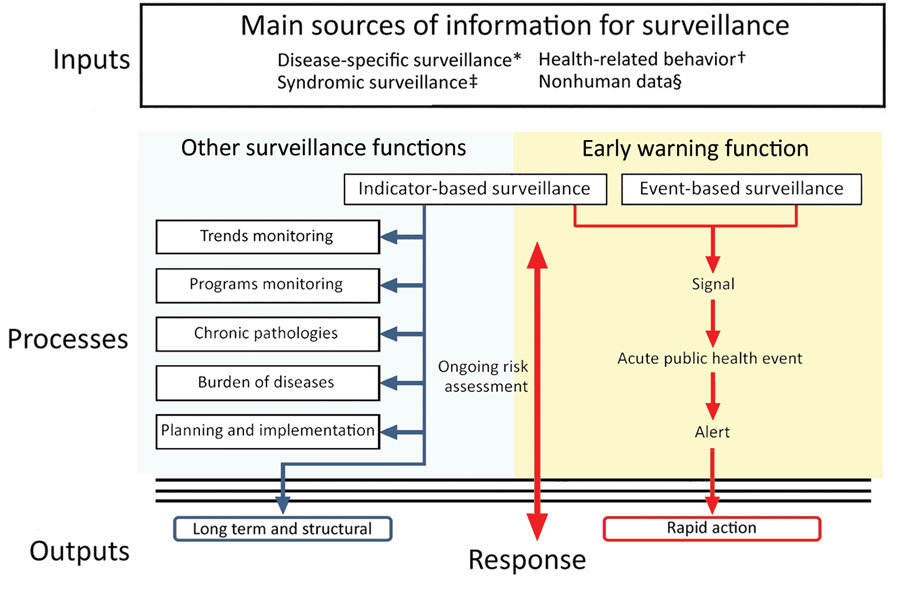Volume 28, Supplement—December 2022
SUPPLEMENT ISSUE
Surveillance
Lessons Learned from CDC’s Global COVID-19 Early Warning and Response Surveillance System
Figure 1

Figure 1. Overview of public health surveillance and response functions used in an evaluation of the Centers for Disease Control and Prevention Early Warning and Response Surveillance system. Adapted from the World Health Organization (4). *Conventional human surveillance based on biological confirmation of cases.†Human case data based on syndromic definition. ‡Data and information in relation to human health (e.g., media reports, sick leave, medicine sales, population movement, social unrest, etc.). §Veterinary surveillance (zoonosis), environmental or biological surveillance (e.g., meteorlogical, vector density, water and air quality, etc.).
References
- He B. Many cases of pneumonia of unknown cause in Wuhan are now worrying that SARS is coming again. Experts from the National Health and Medical Commission arrived in Wuhan for testing and verification [In Chinese]. Ming Pao Daily News. 2019 Dec 31 [cited 2019 Dec 31]. https://news.mingpao.com
- Centers for Disease Control and Prevention. CDC SARS response timeline [cited 2022 May 13]. https://www.cdc.gov/about/history/sars/timeline.htm
- World Health Organization. Early detection, assessment and response to acute public helath events: implementation of early warning and response with a focus on event-based surveillance. Geneva: The Organization: 2014.
- World Health Organization. Protocol for assessing national surveillance and response capacities for the IHR (2005). Geneva: The Organization; 2010.
- Balajee SA, Salyer SJ, Greene-Cramer B, Sadek M, Mounts AW. The practice of event-based surveillance: concept and methods. Glob Secur Health Sci Policy. 2021;6:1–9. DOIGoogle Scholar
- Wang YA, Barry M. Making online outbreak surveillance work for all. Ann Glob Health. 2017;83:625–9. DOIPubMedGoogle Scholar
- Dong E, Du H, Gardner L. An interactive web-based dashboard to track COVID-19 in real time. Lancet Infect Dis. 2020;20:533–4. DOIPubMedGoogle Scholar
- European Centre for Disease Prevention and Control. How ECDC collects and processes COVID-19 data [cited 2020 Apr 3]. https://www.ecdc.europa.eu/en/covid-19/data-collection
- Wazny K. Applications of crowdsourcing in health: an overview. J Glob Health. 2018;8:
010502 . DOIPubMedGoogle Scholar - World Health Organization. Epidemic intelligence from open sources [cited 2020 Oct 2]. https://wwwwhoint/eios
- World Health Organization. International health regulations, 3rd edition. Geneva: The Organization; 2016.
- World Health Organization. Global surveillance for human infection with novel coronavirus (2019-nCoV): interim guidance, 31 January 2020. Geneva: The Organization; 2020.
- World Health Organization. Global surveillance for COVID-19 disease caused by human infection with novel coronavirus (COVID-19): interim guidance, 27 February 2020. Geneva: The Organization; 2020.
- World Health Organization. Novel coronavirus (2019-nCoV) situation reports 2 March 2020 [cited 2020 Mar 2]. https://www.who.int/emergencies/diseases/novel-coronavirus-2019/situation-reports
- World Health Organization. Novel coronavirus (2019-nCoV) situation reports 7 March 2020 [cited 2020 Mar 7]. https://www.who.int/emergencies/diseases/novel-coronavirus-2019/situation-reports
- Johns Hopkins University. COVID-19 data repository by the Center for Systems Science and Engineering (CSSE) at Johns Hopkins University [cited 2020 Mar 22]. https://github.com/CSSEGISandData/COVID-19
- European Centre for Disease Prevention and Control. How ECDC collects and processes COVID-19 data [cited 2020 Apr 3]. https://www.ecdc.europa.eu/en/covid-19/data-collection
- Dawood FS, Ricks P, Njie GJ, Daugherty M, Davis W, Fuller JA, et al. Observations of the global epidemiology of COVID-19 from the prepandemic period using web-based surveillance: a cross-sectional analysis. Lancet Infect Dis. 2020;20:1255–62. DOIPubMedGoogle Scholar
- Biggerstaff M, Cowling BJ, Cucunubá ZM, Dinh L, Ferguson NM, Gao H, et al.; WHO COVID-19 Modelling Parameters Group. Early insights from statistical and mathematical modeling of key epidemiologic parameters of COVID-19. Emerg Infect Dis. 2020;26:e1–14. DOIPubMedGoogle Scholar
- Centers for Disease Control and Prevention. Travelers’ health [cited 2020 Mar 5]. https://wwwnc.cdc.gov/travel
Page created: June 01, 2022
Page updated: December 11, 2022
Page reviewed: December 11, 2022
The conclusions, findings, and opinions expressed by authors contributing to this journal do not necessarily reflect the official position of the U.S. Department of Health and Human Services, the Public Health Service, the Centers for Disease Control and Prevention, or the authors' affiliated institutions. Use of trade names is for identification only and does not imply endorsement by any of the groups named above.